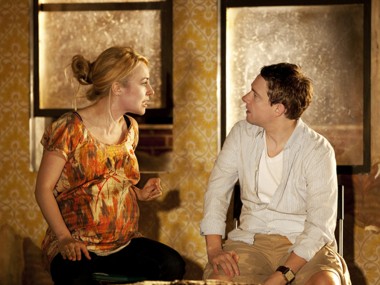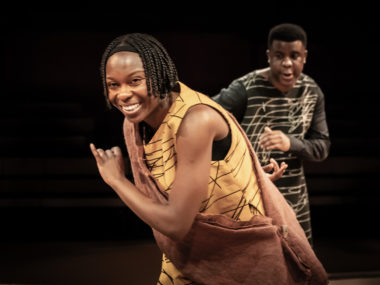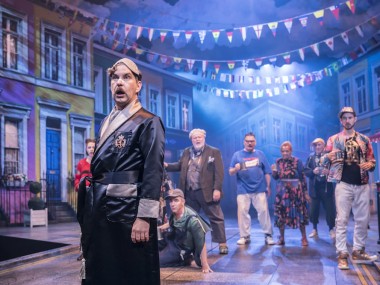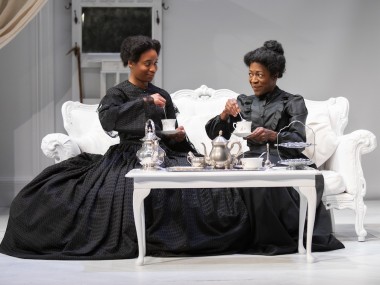Beneatha’s Place, Young Vic
Wednesday 5th July 2023
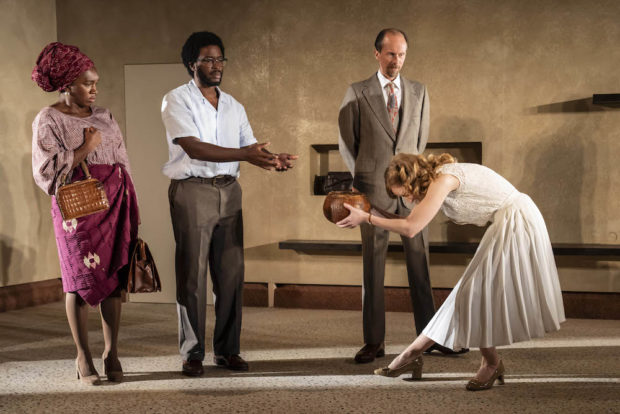
Trauma is the source of identity politics. In the case of African-Americans, the experience of brutal slavery, exploitative colonialism and violent racism are defining experiences in their history. Although many recent black dramas have contested this with images of a more celebratory kind of identity, it remains a standard trope, as proved by Kwame Kwei-Armah’s 2013 play, Beneatha’s Place, which he revives and directs himself at the Young Vic, where he is artistic director. In it he channels, among other things, his own experiences of living and working in the United States between 2011 and 2018.
An intertextual tribute to African-American culture, Kwei-Armah’s story is rooted in Lorraine Hansberry’s A Raisin in the Sun, which in 1959 was the first play by a black woman to be staged on Broadway. In that drama, set in Chicago’s working-class South Side, Beneatha is Lena’s idealistic 20-year-old daughter and her dream is to be a medical student despite racial prejudice. When the family is ruined and lose all their money, Joseph Asagai, a Nigerian student, asks Beneatha to marry him and come with him when he returns to Africa, part of that era’s “Back to Africa” movement. Although Hansberry leaves Beneatha’s choice uncertain, Kwei-Armah lends her a helping hand.
The first act of his story shows Beneatha and Asagai arriving in a white neighbourhood of Lagos in 1959 as the country is struggling for independence. Initially the tone is hilariously comic as Asagai, now a university professor and political activist, and his medical student wife are introduced to their new home by the ridiculously patronizing and openly racist white Alabama missionaries Mr and Mrs Nelson. Just as living in the white neighbourhood of Clybourne Park was a dream for the black family in Hansberry’s play, here it becomes a re-run of the racial confrontations of Bruce Norris’s 2010 piece Clybourne Park.
As the Nelsons depart for the States, comedy turns into something more serious. While Beneatha and Asagai begin to unpack their stuff, which includes his shocking collection of appallingly racist Jim Crow memorabilia (kept to remind black people about pervasive prejudice in the West), the political situation is sketched out. At one point, his Aunty Fola tells Beneatha that her husband is in a risky position because of tensions within the independence movement. The arrival of white American Daniel, probably a CIA agent, increases the tension. The problem with this flawed act is that the political situation is unclear and, despite some strong insights into American racism of the 1950s, the storytelling lacks impact because it’s hard to see exactly what’s at stake.
The play’s second half is stronger and clearer. Although the first half is more about Asagai when really we want to know about his wife, it does provide the trauma that changes her life, and the second act shows her aged 70, an American social anthropologist and Ivy League university dean (a chronology unnecessarily muddled by seemingly being set during the pandemic when she would be in her 80s and surely retired). What is thrilling is that Beneatha has returned to her old Lagos home from America, and assembled her academic colleagues — in Nigeria for a conference — to discuss the state of black studies at their institution.
This act is much more successful than the first in that there is some real fire in the culture wars debate, which is still contemporary, about whether these academics should continue African American studies or instead launch a critical whiteness course. Here the play catches fire with provocative comments not only by Beneatha, but also by her white colleagues, such as Mark and Harriet, who want change, and Gary and Wale, a scion of a petro-rich black family, who don’t. Their discussion is rich in ideas and aggressions, both micro and macro.
The notion of white privilege, the rights of white people to pontificate on race issues, and even to teach black studies rather than critically examining their own social and cultural advantages, are all issues which are critically grappled with. The idea that black students are no longer interested in the trauma of previous generations and want a much more celebratory notion of race clashes with the experience of everyday racism in both USA and UK. For white students, is guilt now a bore, and how can they support anti-racism without taking a white saviour role? Kwei-Armah offers no easy answers and the play ends quietly as Beneatha, left alone, contemplates her life’s achievements and its losses.
The playwright acknowledges the importance of trauma in creating black identity, but also has Beneatha question this idea when she says, “Traumatic is being on a slave ship — having your land pulled from beneath you”, but not revisiting your past and arguing with academic colleagues. He also has some fun with his portrayal of intellectuals as narrow-minded and self-serving, along with some good jokes. When Mark tells Gary he should consider his white privilege, Gary answers: “I’d rather count the wrinkles on my dog’s balls.” And there’s a laugh about “white on white” aggression. With its mentions of George Orwell as well as Marcus Garvey, and its scepticism towards our need for heroes, the play has a panoramic feel as well as some brightly satirical passages.
Being part of an informal trilogy, along with A Raisin in the Sun and Clybourne Park, means that Beneatha’s Place furthers the discourse on the African diaspora. The relationship between West Africa and the southern states of America, and the grim legacy of the transatlantic slave trade, are all highlighted. Nor is Britain ignored: Nigeria was a British colony until 1960, and Beneatha in Kwei-Armah’s play has a recording, which she plays and dances to, of Lord Kitchener’s celebratory calypso “The Birth of Ghana” (another British colony, which became independent in 1957). At the same time the playwright also includes the issue of class: he shows that being white is not so privileged if you are poor, and that being super rich means that skin colour is less of an impediment.
Designed by Debbie Duru, the playwright’s production of his work — which originally premiered in rep with Clybourne Park at Baltimore’s Center Stage, when he was artistic director there — is powerful, often comic, but also rather static. It’s an uneven play, but this revival features a dignified and commanding central performance by Cherrelle Skeete as Beneatha, who ages convincingly, and is well served by the rest of the cast who play two roles each: Zackary Momoh (Asagai/Wale), Sebastian Armesto (Daniel/Mark), Tom Godwin (Nelson/Gary) and Nia Gwynne (Mrs Nelson/Harriet). Jumoké Fashola gets some good laughs with her portrayal of Aunty Fola. At its best, the play is a panoramic satire which engages thought-provokingly with Hansberry and Norris; pity that its first part is flawed.
This review first appeared on The Arts Desk

